From horse to horsepower
Don Wheatcroft
Growing up in Chipping Campden in the 1900’s I can tell you about some of the great changes to the means of transport in and around the town over the years
From horse-drawn carts, early motorcycles, the first cars and on to the ever-improving farm machinery. In some cases a few details about their owners too I hope will bring this all to life.
At Springhill Estate near Broadway Tower Captain Hannay had a team of Suffolk Punch horses distinctive both in colour and size. Three of these, two pulling empty two-wheeled tip-carts would trot down into Campden and on to the station. Beautifully dressed by the carter, with ribbons plaited into their mains, they reflected the pride the Captain took in his horses. Their purpose was to collect a truck-load of coal delivered there for them. On the return journey two horses pulled the two filled tip carts, the third horse in front helping to pull them all the way up the long hills home.
Len Potter from Broad Campden owned a stallion that he walked miles with to serve the mares owned by farmers all around the local countryside. No such thing as horse-boxes back then. I will deviate for a moment to say that I can remember the first cattle trucks that brought stock to the monthly Wednesday Campden cattle market. The heavy back doors were not spring loaded as they are today and it would take every effort of a couple of strong men to lift and close those doors.
All the farmers worked their land with horses back then
Our first horse ‘Prince’ was a ”half-leg” which my Father bought along with a four-wheel dray. This fitted onto the horse’ shafts by a fixed round iron plate on top of which a rotating plate on the ends of the shafts was pinned to with an iron bolt through the centre, so enabling the dray to pivot. Our second horse was an ex pit pony, slightly lame from his labours at the mine, though never in pain. His name was Tommy, but we lovingly nicknamed him ‘three ha’pence and tu’pence’. He came with a small trap that my brother and I used for hawking our vegetables round the town. Another of our horses had been ‘broken-in’ with cart horses, so would only move with long strides working at one pace – slow! Another local farmer, Mr Gladwin, father of Walter and Alan, was affected by polio, I believe, and relied on the help of his pony and buggy to get him around his farmland..
I can remember several tradesmen in the town itself and further afield who carried their wares from horse-drawn carts. There was Mr Foster who sold oil from a 50gallon barrel standing on a low-bed cart. He could be heard traversing the town calling ‘Oil, Oil’. Then Joe Court, always wearing his bowler hat, collected ashes and rubble with a pony and cart, for his work filling potholes in the roads. A Mr Wootten and his son regularly came into Campden selling salt from a horse-drawn trolley. The salt was cut into loaf-sized blocks the size of a large loaf, for which he charged 1/- or 1/6d. Mr Wootten’s selling technique was to tell each customer ‘I just got one bar left M’am’! I think we all new better! Milk was delivered from Haydon’s and Haines’ dairies by horse and cart. Coal merchants Garnet Keyte from Sheep street, the Keeley brothers from Park road and Ted Nobes all delivered their coal with horse and cart. Ted’s was the last horse and cart in Campden.
Now for my earliest memories of locomotives – Steam engines
The daily walk to and from school was so much more exciting the days the steam engines came chugging and puffing their way along the road delivering goods. Flowers of Stratford upon Avon delivered casks of cider and beer to the Campden pubs and Healings of Tewkesbury brought flour to Heritage’s bakery. These iron monsters with their coal fires, chimneys and solid rubber tyres were impressive indeed. The front wheels were powered by the steam and the back wheels were driven by chains and sprockets.
Next, transport of the two-wheeled variety
In the school holidays one year, to earn some pocket money, I pedalled the town delivering groceries carried in a big basket on the front of the bike, similar to the novel ice-cream vendors of today. Two of the first motorcycles in the town were owned by my eldest brother George and one of the Pitcher family who lived behind Ladbrooke’s the butcher. George’s was a Spartan, belt driven as opposed to chain-and-sprocket, which when riding uphill in the rain would lose some of its drive. The other was a Brough Superior and a very good machine it was too. A little anecdote to slip in here: George was riding back from visiting a girlfriend in Evesham one pitch-black, foggy evening with only Carbide lighting to light his way. Slowly negotiating his way up Aston hill he suddenly found himself riding towards a courting couple walking arm-in-arm, swiftly separating them!
My next brother, Lewis, bought a Levis, also belt driven, which he rode to and fro on his occasional week-ends home from Coventry where he worked and lodged for 30/- a week (food and lodging included)! He often wore all-in-one over trousers and boots, made of rubber, which were great protection from the elements. Another brother, Sidney, bought himself a brand new BSA Goldstar from Robbins’ garage in Port St, Evesham. Frequently he rode this to Hereford and back in an evening to visit his young lady and to avoid Father’s disapproval would turn off the engine at the top of Dyers lane and freewheel all the way down to our drive in Park Road! My own bike was a Panther 600cc which I bought after the war.
The first car I can remember actually owned by a Campden resident was a Ford
This belonged to Mr Jones in Sheep Street. Then there was a Mr Chandler, a millionaire, who had a residence in Ebrington. He drove a Lagonda and brought his daughter down to the riding stables at Westington Mill for her riding lessons. This car had a distinctive exhaust note, similar to a sports car of today, which could be heard from some considerable distance. A stark contrast to the rhythmic clopping of horses that the town had been used to.
Years later my father’s first car was a new Singer, purchased through his daughter-in-law who worked for the Singer company. Sadly his experiences with this car were not at all positive. His first attempt at driving it was along the grassy mile drive on Campden House estate where he rented some land. Unfortunately attempting to turn left out onto the main road instead he shot across the road ending up in the wall opposite and never ever drove a car again! Another day he decided to clean the car so with water and bass broom he removed all the dirt very successfully until he discovered he had left scratch marks all over the paintwork!
Bert Lydiatt was a local carpenter and joiner who owned a Morgan three-wheeler. Unusually, this was started with a starter handle at the side of the vehicle as opposed to the front.
When I returned to Campden after the war in 1946 my brother Lewis contacted me to see if I wanted to buy an Austin7 that he knew was for sale. I purchased this for £30 and it served us well until one day endeavouring to drive up Saintbury Hill it started playing-up and the only way we could reach the top was to reverse all the way up instead! On a previous occasion when Edna my wife was driving it from our home at Hill Barn, Blockley, she ran out of petrol. This being after the war petrol was still rationed, but a kindly lorry driver who found her in this plight, put a couple of gallons in the tank, which was under the bonnet, and went on his way. A great kindness remembered with gratitude.
George Haysum owned a Morris Commercial bus, started with a starter handle, with which he ran a regular service to and from the station three miles out of the town. It held about twelve people and their luggage he stacked up beside him in the open-sided cab. The cost of the trip was 3d per person.
Ward’s of Evesham came round Campden regularly in their lorry specially adapted to sell their household wares. The sides rolled up to reveal shelves sloping backwards displaying all their goods for customers to view and buy from. A galvanised tin bath usually hung at the back
The first lorry my Father bought was a Ford T 30cwt which my brother George drove. It had a two-speed pedal, no gears and was very noisy and slow when climbing hills. We mostly used it to carry our fruit to Evesham market, so all through the winter it was parked up until we re-licensed it the following summer. We bought the lorry from Jack Horne in Leasebourne. He had used it for deliveries of the corn he milled and the animal feed supplies from his shop. Jack also had a bus which he used as a taxi. It was usually driven by Charlie Blake. Sometimes my father hired the bus and driver to take our family and friends to visit other towns. Later we bought a brand new Bedford lorry which we used to carry the sprouts from our farm to Gladwin’s yard and of course the fruit for the market in Evesham.
Tractors
The first tractor I remember was owned by the Sezincote estate and was a Lanz Bulldog, a German made single cylinder tractor. You could hear it’s distinctive ‘thump, thump, thump’ from miles away. Will Haines had a new Standard Fordson and I remember seeing his son Horace Haines cultivating the land behind the Craves with it when it was brand new. The first tractor my father bought was a Fordson reg. BWP 664 which he bought along with an assortment of implements for £120. This was the era before hydraulics, three point linkage and depth control. As with most of the tractors at this time it had to be started using a starting handle. These could sometimes ‘kick back’ and my brother George had his arm broken twice by this. I will slip in here an interesting aside concerning George. While I was away in the army during the war he and his wife were taking a walk up Conduit Hill passing some of the small abandoned and overgrown Quarry pits. In one of these hollows they discovered a grease gun, and bucket-held grease gun and some full and half full cans of engine oil. It seemed the American soldiers who had been based near Campden had dumped them in the undergrowth before moving on to their next base. This was a very useful find and kept our implements well oiled for some considerable time. Our second tractor was an Alice Chalmers Model B followed by a bigger model U and a model M crawler. While I was using one of the tractors, I can’t remember which, a gentleman stopped by to watch and then proceeded to tell me that there would soon be a Ferguson tractor on the market with a three-point linkage. It turned out to be none other than Mr Harry Ferguson himself who was staying as a guest of Captain Coles, our landlord. Avon Valley Tractors became the agents for Ferguson’s and H. Burlingham & Co became the agents for Alice Chalmers, both firms being in Evesham. At one stage we owned a Field Marshall which was a single cylinder diesel. My brother Sidney had a Case model DEX made abroad somewhere. The company slogan was ”In any Case you’ll be satisfied”!
When my father took the tenancy of the farm on Campden House estate, the previous tenant had a Fisher-Humphris threshing drum, which I believe was made in Pershore. This was still used in situ that year to thresh his remaining sheaves of corn. The mechanism operated by belts and pulleys, one of which was attached to the side of a tractor by which the thresher was powered.
Our first combine harvester was trailer-drawn and had a sacking-off platform with two chutes, one to collect the grain and one for the dust. We hired thick hessian sacks from Hudson’s Sack Hire at Gloucester. When full they could hold 2 ¼ cwt of wheat or 2 cwt of barley. The next combine we had was a Massey-Harris 726, and the next a 780. Following this and much later, we had a bulk holding Dutch-made Clayson. Hector Smith had 3 Massey 21’s with a 12′ cut which was a wide cut in those days. Most were 7’6 wide. These were imported from Canada or America, I can’t remember which.
From this era onwards implements and vehicles rapidly and constantly progress so I will finish here and trust you have found it to be interesting and enjoyable reading.

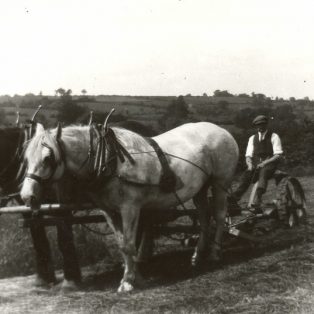
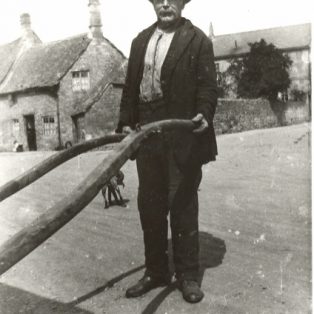
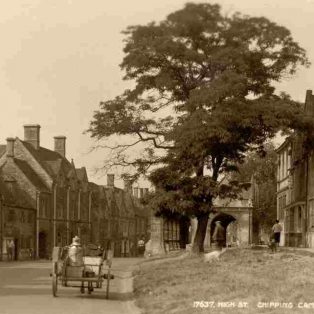
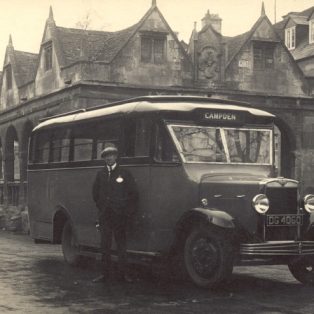
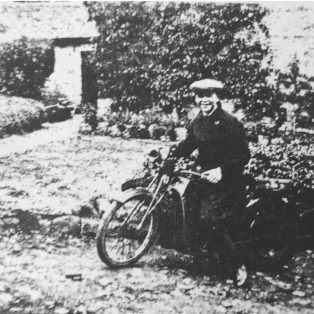





No Comments
Add a comment about this page